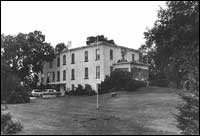


View images of a forgotten history

1925 report on conditions at poorhouses
Articles on poorfarm law
A history of the Anoka County poorfarm
poorhousestory.com
Johnson County, Iowa, poorfarm
Wythe County, Va., poorhouse farm


Producers: Dan Gunderson and Chris Julin
Broadcast editor: Euan Kerr
Online editor: Melanie Sommer
Art director: Ben Tesch
Production supervisor: Michael Wells
Narrator: Earl Leaf
Historical voice: Steve Stark

|  |
Over the Hill to the Poor House
July 29, 2002
By Dan Gunderson and Chris Julin, Minnesota Public Radio

The American dream is freedom and financial security. But it's possible to lose everything. One day you have a job, a family, a house. Then there's an accident, an illness, a poor choice. One misfortune piles on another.
One hundred years ago, if you lost your health, or your mind, you might have faced the poorhouse. It was a terrifying possibility - the slide from working, healthy person to the poorhouse, an anonymous death, and an unmarked grave.
Thousands of people died in poorhouses, and today we park cars and grow corn on their graves. Poorhouses disappeared after World War II, but some people wonder how far we've come from a time when poor people were simply thrown away.

History of the Poorfarm
It was thought poorhouses would be a more efficient way of caring for the poor,
thus reducing cost for local government. It was also anticipated that by forcing
people to go to a less than pleasant place if they wanted public assistance,
many poor could be discouraged from seeking help.
Working at the Poorhouse
The poorhouse is a mostly forgotten part of American history. But a few people still remember - especially those who worked in the poorhouses.
Looking for Graves
Many of the residents of Minnesota's poorhouses and poorfarms ended up in unmarked graves - in unmarked cemeteries that few people know about. Now some are trying to find and preserve those graves, to provide the dead the dignity they did not have in life. View photos of poorhouse cemeteries
Take a a multi-media tour of a poorhouse (RealAudio)
What life was like at the Brown County poorfarm
A poorfarm in Johnson County, Iowa is a reminder of history
The last poorhouse?
The Town Lodging House in Easthampton, Mass., may be the only poorhouse in the U.S. that's still in operation. It's been housing poor people since 1891.

How does society treat poor people today, compared to the era of the poorhouse? Share your thoughts in the MPR Forum.
|